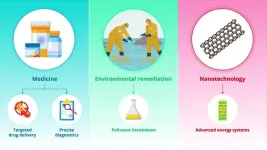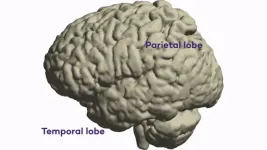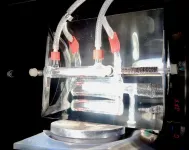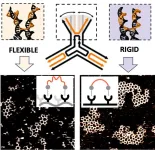(Press-News.org) COLUMBUS, Ohio – How do you tell if someone has a particular accent? It might seem obvious: You hear someone pronounce words in a way that is different from “normal” and connect it to other people from a specific place.
But a new study suggests that might not be the case.
“People probably don’t learn who has an accent from hearing someone talk and thinking, ‘huh, they sound funny’ – even though sometimes it feels like that’s how we do it,” said Kathryn Campbell-Kibler, author of the study and associate professor of linguistics at The Ohio State University.
Accents may be more of something we learn culturally, Campbell-Kibler said.
The study was published online recently in the Journal of Sociolinguistics.
The study is part of a long-term project that Ohio State researchers have been conducting at the Language Sciences Research Lab at the Center of Science and Industry (COSI), a science museum in Columbus.
In this study, researchers asked visitors to the museum to participate in a study about accents. In the end, 1,106 people age 9 and up – mostly Ohioans – took part.
All participants heard a series of recordings, each featuring a speaker saying several words, all with the same vowel in them.
“Americans often listen to vowels to judge how much of an accent someone has,” Campbell-Kibler said.
For example, some people may pronounce “pen” so that it sounds to others like they are saying “pin.”
In all, participants heard 15 speakers pronounce words like “pass,” “food” and “pen.”
Participants rated each speaker on a scale from “not at all accented” to “very accented.”
Although the participants weren’t told this at the time, all the speakers had grown up in one of three regions of Ohio that linguists have coded as having particular accents: northern Ohio (the Inland North accent), central Ohio (the Midland accent) and southern Ohio (the South accent).
After rating the accents of the people they heard, participants were then asked to rate how accented they thought the speech was in various parts of Ohio on a scale of 0 (no accent) to 100 (very accented). Based on the similarity of answers, Campbell-Kibler was able to collapse them into the three categories of northern, central and southern Ohio.
In general, museum visitors thought people from southern Ohio had the strongest accents, somewhere near 60 to 70 on the scale. Central Ohio residents didn’t have much of an accent, according to participants, with a score averaging 20 to 25. They weren’t sure about northern Ohio residents, who had a score near 50 on the scale.
Results showed that Ohioans take until adulthood to fully absorb these beliefs about the differing accents in the state. The 9-year-old participants didn’t show much differentiation in perceptions between north and south – it took until about age 25 before the beliefs leveled off.
But here is what most interested Campbell-Kibler about the results.
If a person reported that northern Ohioans in general had a strong, noticeable accent – say they rated them 90 on the scale of 0-100 – you would expect that when they heard a recording of a northern Ohioan speaking, they would rate it as very accented.
But that didn’t occur. People who thought northern Ohioans in general had a strong accent didn’t think the accent of the actual northern Ohio speaker they heard was more accented than those from other areas of the state.
The same was true for the other regions in Ohio that were rated.
“Just because people gave a high rating to the idea that people in southern Ohio have an accent, that doesn’t mean they are good at hearing how actual southern Ohioans pronounce vowels differently,” Campbell-Kibler said.
So if people can’t pick up on accents from hearing them directly, then how do they learn about them?
“It is perplexing. We don’t know the full answer for why this is,” Campbell-Kibler said.
But part of the answer may be that we learn about accents culturally, through other people, and through hearing people on TV shows and movies.
“We may hear friends say they have an aunt in Akron who talks funny or hear people on the TV or the movies from Alabama or Britain talk differently than we do,” Campbell-Kibler said.
“We may not be able to identify an accent – we just know something is there because friends are telling stories about it or we hear the characters on TV.
“There’s a lot more we need to learn about how accents are represented cognitively in our brains,” she said.
END
The complicated question of how we determine who has an accent
A disconnect between how people judge speakers versus regions
2025-02-13
ELSE PRESS RELEASES FROM THIS DATE:
NITech researchers shed light on the mechanisms of bacterial flagellar motors
2025-02-13
When speaking of motors, most people think of those powering vehicles and human machinery. However, biological motors have existed for millions of years in microorganisms. Among these, many bacterial species have tail-like structures—called flagella—that spin around to propel themselves in fluids. These movements employ protein complexes known as the “flagellar motor.”
This flagellar motor consists of two main components: the rotor and the stators. The rotor is a large rotating structure, anchored to the cell membrane, that turns the flagellum. On the other hand, the stators are smaller ...
Study maps new brain regions behind intended speech
2025-02-13
Broca’s aphasia is caused by damage to the frontal lobe, leaves patients unable to say what they intend to say
First study to identify regions outside the frontal lobe that encode the intent to speak
Critical for technology to avoid decoding a patient’s thoughts that are not intended to be spoken aloud
CHICAGO --- Imagine seeing a furry, four-legged animal that meows. Mentally, you know what it is, but the word “cat” is stuck on the tip of your tongue.
This phenomenon, known as Broca’s aphasia or expressive aphasia, is a language disorder that affects a person’s ability to speak or ...
Next-gen Alzheimer’s drugs extend independent living by months
2025-02-13
In the past two years, the Food and Drug Administration has approved two novel Alzheimer’s therapies, based on data from clinical trials showing that both drugs slowed the progression of the disease. But while the approvals of lecanemab and donanemab, both antibody therapies that clear plaque-causing amyloid proteins from the brain, were greeted with enthusiasm by some Alzheimer’s researchers, the response of patients has been muted. According to physicians who care for people with Alzheimer’s, many patients found it difficult to understand what the clinical trials results — presented as “percent decrease in ...
Jumping workouts could help astronauts on the moon and Mars, study in mice suggests
2025-02-13
Jumping workouts could help astronauts prevent the type of cartilage damage they are likely to endure during lengthy missions to Mars and the Moon, a new Johns Hopkins University study suggests.
The research adds to ongoing efforts by space agencies to protect astronauts against deconditioning/getting out of shape due to low gravity, a crucial aspect of their ability to perform spacewalks, handle equipment and repairs, and carry out other physically demanding tasks.
The study, which shows knee cartilage in mice grew healthier following jumping exercises, appears ...
Guardian molecule keeps cells on track – new perspectives for the treatment of liver cancer
2025-02-13
A guardian molecule ensures that liver cells do not lose their identity. This has been discovered by researchers from the German Cancer Research Center (DKFZ), the Hector Institute für Translational Brain Research (HITBR), and from the European Molecular Biology Laboratory (EMBL). The discovery is of great interest for cancer medicine because a change of identity of cells has come into focus as a fundamental principle of carcinogenesis for several years. The Heidelberg researchers were able to show ...
Solar-powered device captures carbon dioxide from air to make sustainable fuel
2025-02-13
Researchers have developed a reactor that pulls carbon dioxide directly from the air and converts it into sustainable fuel, using sunlight as the power source.
The researchers, from the University of Cambridge, say their solar-powered reactor could be used to make fuel to power cars and planes, or the many chemicals and pharmaceuticals products we rely on. It could also be used to generate fuel in remote or off-grid locations.
Unlike most carbon capture technologies, the reactor developed by the Cambridge researchers does not require fossil-fuel-based power, or the transport and storage of carbon dioxide, but instead converts atmospheric CO2 into something useful using sunlight. ...
Bacteria evolved to help neighboring cells after death, new research reveals
2025-02-13
Darwin’s theory of natural selection provides an explanation for why organisms develop traits that help them survive and reproduce.
Because of this, death is often seen as a failure rather than a process shaped by evolution.
When organisms die, their molecules need to be broken down for reuse by other living things.
Such recycling of nutrients is necessary for new life to grow.
Now a study led by Professor Martin Cann of ...
Lack of discussion drives traditional gender roles in parenthood
2025-02-13
Conversations about parental duties continue to be led by mothers, even if both parents earn the same amount of money, finds a new study by a UCL researcher.
A new study by Dr Clare Stovell (IOE, UCL’s Faculty of Education & Society), published in the Journal of Family Studies, highlights how a lack of discussion between parents about important choices such as parental leave, work and childcare is perpetuating traditional gender roles.
The study found that women usually lead the conversations and there is little discussion about the man’s work schedule, even in cases where the woman earns as much or more than her partner.
Dr Stovell said: “These interviews ...
Scientists discover mechanism driving molecular network formation
2025-02-13
Covalent bonding is a widely understood phenomenon that joins the atoms of a molecule by a shared electron pair. But in nature, patterns of molecules can also be connected through weaker, more dynamic forces that give rise to supramolecular networks. These can self-assemble from an initial molecular cluster, or crystal, and grow into large, stable architectures.
Supramolecular networks are essential for maintaining the structure and function of biological systems. For example, to ‘eat’, cells rely ...
Comprehensive global study shows pesticides are major contributor to biodiversity crisis
2025-02-13
Pesticides are causing overwhelming negative effects on hundreds of species of microbes, fungi, plants, insects, fish, birds and mammals that they are not intended to harm – and globally their use is a major contributor to the biodiversity crisis.
That is the finding of the first study assessing the impacts of pesticides across all types of species in land and water habitats, carried out by an international research team that included the UK Centre for Ecology & Hydrology (UKCEH) and the University of Sussex.
Multiple negative impacts
The scientists analysed over 1,700 existing lab and field studies of the impacts of 471 different ...
LAST 30 PRESS RELEASES:
Norbert Holtkamp appointed director of Fermi National Accelerator Laboratory
New agentic AI platform accelerates advanced optics design
Biologists discover neurons use physical signals — not electricity — to stabilize communication
Researchers discover that a hormone can access the brain by hitchhiking
University of Oklahoma researcher awarded funding to pursue AI-powered material design
Exploring how the visual system recovers following injury
Support for parents with infants at pediatric check-ups leads to better reading and math skills in elementary school
Kids’ behavioral health is a growing share of family health costs
Day & night: Cancer disrupts the brain’s natural rhythm
COVID-19 vaccination significantly reduces risk to pregnant women and baby
The role of vaccination in maternal and perinatal outcomes associated with COVID-19 in pregnancy
Mayo Clinic smartwatch system helps parents shorten and defuse children's severe tantrums early
Behavioral health spending spikes to 40% of all children’s health expenditures, nearly doubling in a decade
Digital cognitive behavioral treatment for generalized anxiety disorder
Expenditures for pediatric behavioral health care over time and estimated family financial burden
Air conditioning in nursing homes and mortality during extreme heat
The Alps to lose a record number of glaciers in the next decade
What makes a good proton conductor?
New science reporting guide published for journalists in Bulgaria
New international study reveals major survival gaps among children with cancer
New science reporting guide published for journalists in Turkey
Scientists develop a smarter mRNA therapy that knows which cells to target
Neuroanatomy-informed brain–machine hybrid intelligence for robust acoustic target detection
Eight SwRI hydrogen projects funded by ENERGYWERX
The Lundquist Institute and its start-up company Vitalex Biosciences Announces Strategic Advancement of Second-Generation fungal Vaccine VXV-01 through Phase 1 Trials under $40 Million Competitive Con
Fine particles in pollution are associated with early signs of autoimmune disease
Review article | Towards a Global Ground-Based Earth Observatory (GGBEO): Leveraging existing systems and networks
Penn and UMich create world’s smallest programmable, autonomous robots
Cleveland researchers launch first major study to address ‘hidden performance killer’ in athletes
To connect across politics, try saying what you oppose
[Press-News.org] The complicated question of how we determine who has an accentA disconnect between how people judge speakers versus regions





